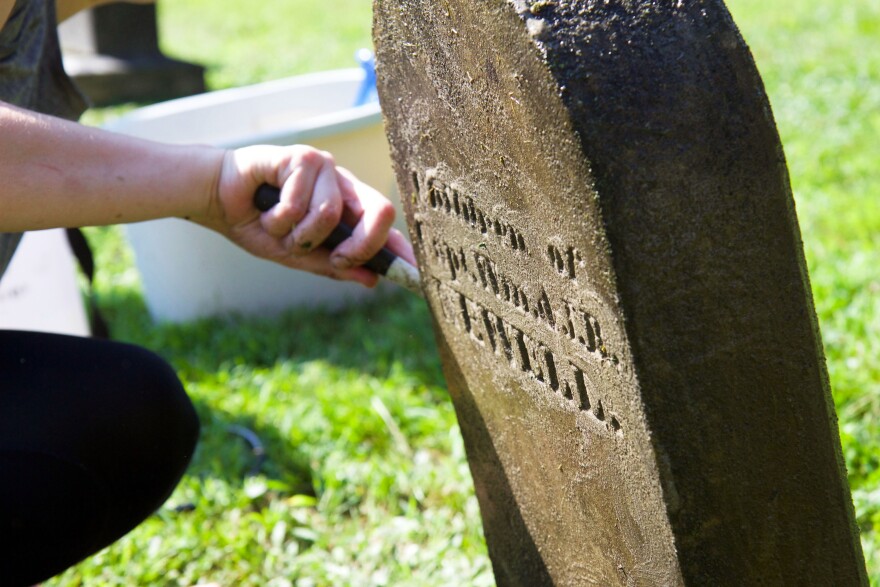At 9:30 in the morning on one of the hottest days in August, it was still cool at Maple Hill Cemetery in the town of Dorset. That is the time of day when Caitlin Abrams likes to come here. She wore rubber boots in the dewy grass that soon, a man would start to mow. She walked over to a marble stone, whiter than the rest.
It reads, “Joseph Porter Baldwin, son of Silas and Sarah Baldwin, who died April 26 1811, in the sixth year of his age. His death was occasioned by accidentally falling under the pitman of a sawmill, which instantly terminated his existence.”
Caitlin cleaned this grave recently. That’s what she does here.
She read the epitaph aloud: “All you that walk around my tomb, may see where to all nature comes, though you are young, yet you may die and sleep in death as well as I.”
See the grave in the video below:
Last spring, Caitlin received a one-off request to clean a gravestone. It turned into a hobby — and internet fame.
Now, the 35-year-old West Rupert resident finds time some mornings to visit one of four cemeteries where she has permission to carefully, expertly remove centuries of moss and dirt from 18th and 19th century headstones. And she’s gained nearly 1.5 million followers on TikTok for the videos she makes of herself doing it.
“The stone picks me in some cases,” she said. “There are some that just catch my eye immediately. And it's kind of like, I can't shake it, sort of thing. It's like: that one. Like it's just an immediate — that one."
More from VPR: 'Extremely Busy': Amid The Pandemic, Barre's Granite Industry Booms
Caitlin likes to reveal the words chosen by the deceased’s relatives, and the symbols carved at the top of the stone, like a willow tree or a rose bush with a broken bud. She likes to see the names, like William, Adelade, and Ida Grace.
She sprays the stone with water, and a special cleaning solution. She kneels, in black leggings and a grey t-shirt, reaching for her tools with a tattooed arm. She scrubs with soft brushes, gently clearing moss and lichen away from words that haven’t been read in generations.

“The actual physical work of it is very meditative,” she explained. “It's sort of in the spaces in between, I kind of start piecing the person together in my head.”
It’s in those spaces in between, as she waits for the cleaning solution to do its work, that she might look the person up online and see what records she can find to put their story together:
“It's kind of bringing the past to life for myself, like to be able to kind of see it — in whatever way I can — to kind of build a story around it.”
Caitlin is interested in the stories of everyday people. Of women, especially, whose lives went intentionally unremembered. And of children, whose stones she can find easily, because they’re usually small.
Click below for a video portrait of Caitlin Abrams:
She had cancer when she was 4, and her best friend died of leukemia when Caitlin was 9.
“When he died, it was very much like: and he's gone. And I didn't really know what that meant, especially because I'd had cancer, and I was still here," Caitlin said. "And why had he suffered so much more than I did? ... And I was only 9.”
Now a mother of two, she says she would want someone to care for her own children's resting places long after she’s gone.
More from VPR: In Memoriam: Troy's Only Covered Bridge
For Caitlin, to clean a grave, to make it bright and legible again, is to reach across the gap between the known and unknown, the then and the now, the dead and the living.
“I just want to talk to them,” she said. “I want to know these weird things that they said to each other, and these weird, like, idioms that we have no idea exist, because they didn't write all this down. Because you can give me census records, you can give me dates, you can give me birth and death and all that. But that doesn’t tell me anything really. I want to find out what all that extra stuff is.”
Some of the very first stones she cleaned are three small ones standing in a row, belonging to Stella, Oliver and Jesse. They died of diphtheria in the 1860s at the ages of 3, 5 and 3.

“And then you can kind of start piecing,” she said, gesturing at the two larger stones next to them. “We have their mother and their father here, their father died just a year after these two, [in] 1866. So she went through the death of three children and her husband, all within a pretty short span. And she lived to the age of 78, dying in 1901.”
Her epitaph reads, “Love suffereth long and is kind.”
Sometimes, Caitlin says, these stories feel like a punch in the chest. Not a blow, but a pain. Because even if you've never experienced that, you know what it feels like. You know it.
“I don't believe in an afterlife," she said. "And I don't believe they're here, any more than they're anywhere else. But I think that there's still something in the shared human experience that we can tap into. And perhaps that is a bit stronger in a place like this.”
And perhaps a bit stronger for a person like Caitlin Abrams, who cleans their graves, and learns their stories, in the rising sun and the dewy grass of an old cemetery, where her only living companion is an old man mowing the grass.
Have questions, comments or tips?Send us a message or get in touch with reporter Anna Van Dine@annasvandine.




